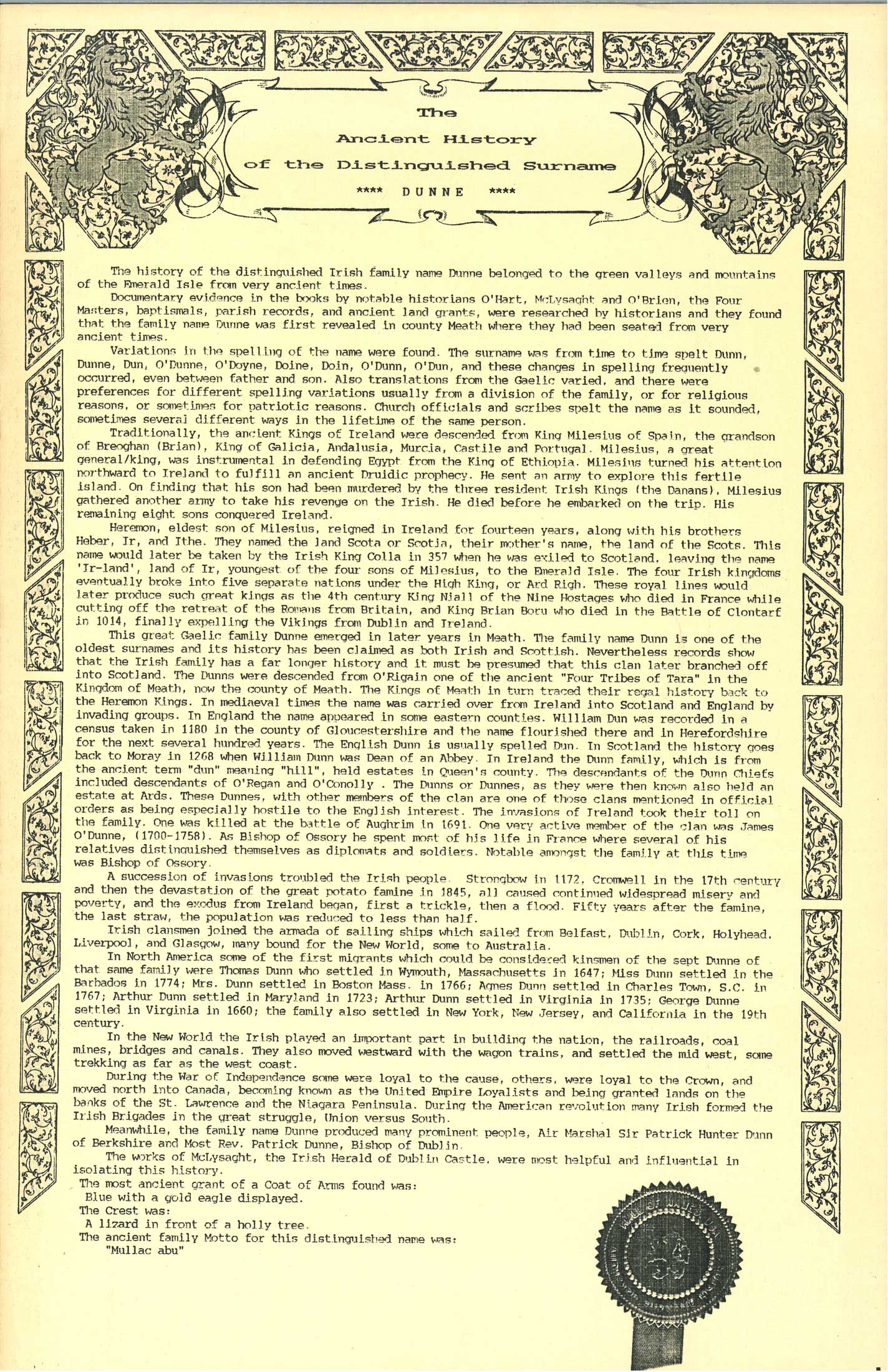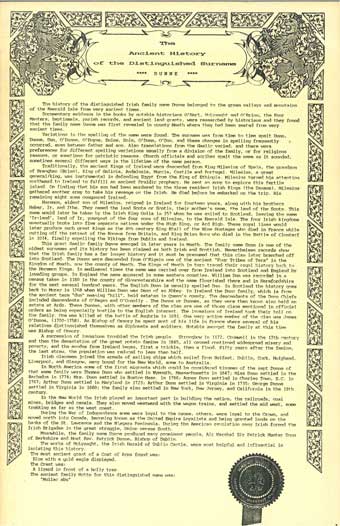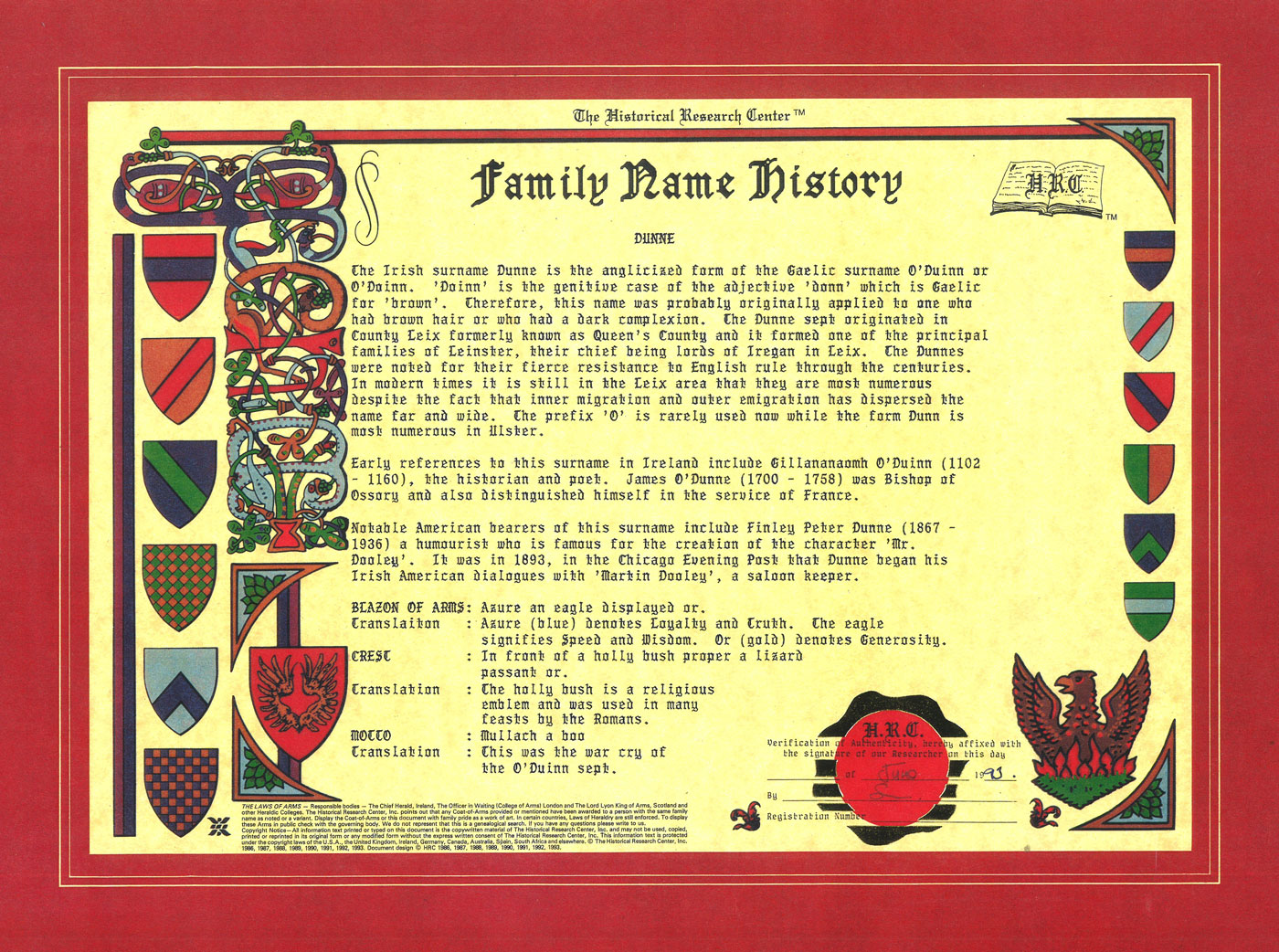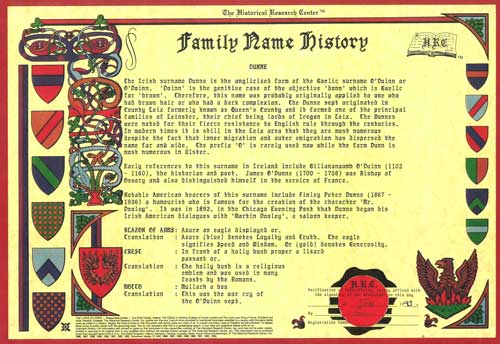History of Surname
The Ancient History of the Distinguished Surname Dunne
The history of the distinguished Irish family name Dunne belonged to the green valleys and mountains of the Emerald Isle from very ancient times.
Documentary evidence in the books by notable histortans O’Hart, McLysaght, and O'Brien, the Four Masters, baptismals, parish records, and ancient land grants, were researched by historians and they found that the family name Dunne was first revealed In county Meath where they had been seated from very ancient times.
Variations in the spelling of the name were found. The surname was from time to time spelt Dunn, Dunne, Dun, O’Dunne, O'Doyne, Doine, Doin, O’Dunn, O’Dun, and these changes in spelling frequently occurred, even between father and son. Also translations from the Gaelic varied, and there were preferences for different spelling variations usually from a division of the family, or for religious reasons, or sometimes for patriotic reasons. Church officials and scribes spelt the name as it sounded, sometimes several different ways in the lifetime of the same person.
Traditionally, the ancient Kings of Ireland were descended from King Milesius of Spain, the grandson of Breoghan (Brian), King of Galicia, Andalusia, Murcia, Castile and Portugal. Milesius, a great general/king, was instrumental in defending Egypt from the King of Ethiopia. Milesius turned his attention northward to Ireland to fulfill an ancient Druidic prophecy. He sent an army to explore this fertile island. On finding that his son had been murdered by the three resident Irish Kings (the Danans), Milesius gathered another army to take his revenge on the Irish. He died before he embarked on the trip. His remaining eight sons conquered Ireland.
Heremon, eldest son of Milesius, reigned in Ireland for fourteen years , along with his brothers Heber, Jr, and Ithe. They named the land Scota or Scotia, their mother's name, the land of the Scots. This name would later be taken by the Irish King Colla in 357 when he was exiled to Scotland, leaving the name ‘Ir-land', land of Ir, youngest of the four sons of Milesius, to the Emerald Isle. The four Irish kingdoms eventually broke into five separate nations under the High King, or Ard Righ. These royal lines would later produce such great kings as the 4th century King Niall of the Nine Hostages who died in France while cutting off the retreat of the Romans from Britain, and King Brian Boru who died in the Battle of Clontarf in 1014, finally expelling the Vikings from Dublin and Ireland.
This great Gaelic family Dunne emerged in later years in Meath. The family name Dunn is one of the oldest surnames and its history has been claimed as both Irish and Scottish. Nevertheless records show that the Irish family has a far longer history and it must be presumed that this clan later branched off into Scotland. The Dunns were descended from O'Rigain one of the ancient "Four Tribes of Tara" in the Kingdom of Meath, now the county of Meath. The Kings of Meath in turn traced their regal history back to the Heremon Kings. In mediaeval times the name was carried over from Ireland into Scotland and England by invading groups. In England the name appeared In some eastern counties. William Dun was recorded In a census taken in 1180 in the county of Gloucestershire and the name flourished there and In Herefordshire for the next several hundred years. The English Dunn is usually spelled Dun. in Scotland the history goes back to Moray in 1268 when William Dunn was Dean of an Abbey. In Ireland the Dunn family, which is from the ancient term "dun" meaning "hill", held estates In Queen's county. The descendants of the Dunn Chiefs included descendants of O'Regan and O’Conolly. The Dunns or Dunnes, as they were then known also held an estate at Ards. These Dunnes, with other members of the clan are one of those clans mentioned in official orders as being especially hostile to the English interest. The invasions of Ireland took their toll on the family. One was killed at the battle of Aughrim In 1691. One very active member of the clan was James O'Dunne, (1700-1758). As Bishop of Ossory he spent most of his life in France where several of his relatives distinfluished themselves as diplomats and soldiers. Notable amongst the family at this time was Bishop of Ossory.
A succession of invasions troubled the Irish people. Stronglbow in 1172, Cromwell in the 17th century and then the devastation of the great potato famine In 1845, all caused continued widespread misery and poverty, and the exodus from Ireland began, first a trickle, then a flood. Fifty years after the famine, the last straw, the population was reduced to less than half.
Irish clansmen joined the armada of sailing ships which sailed from Belfast, Dublin, Cork, Holyhead, Liverpool, and Glasgow, many bound for the New World, some to Australia.
In North America some of the first migrants which could be considered kinsmen of the sept Dunne of that same family were Thomas Dunn who settled in Wymouth, Massachusetts in 1647; Miss Dunn settled in the Barbados in 1774; Mrs. Dunn settled in Boston Mass. in 1766; Agnes Dunn settled in Charles Town, S.C. in 1767; Arthur Dunn settled in Maryland in 1723; Arthur Dunn settled in Virginia in 1735 ; George Dunne settled in Virginia in 1660; the family also settled in New York, New Jersey, and California in the 19th century.
In the New World the Irish played an important part in building the nation, the railroads , coal mines, bridges and canals. They also moved westward with the wagon trains, and settled the mid west, some trekking as far as the west. coast.
During the War of Independence some were loyal to the cause, others, were loyal to the Crown, and moved north into Canada, becoming known as the United Empire Loyalists and being granted lands on the banks of the St- Lawrence and the Niagara Peninsula. During the American revolution any Irish formed the Irish Brigades in the great struggle, Union versus South.
Meanwhile, the family name Dunne produced many prominent people, Air Marshal Sir Patrick Hunter Dunn of Berkshire and Most Rev. Patrick Dunne, Bishop of Dublin.
The works of McLysaght, the Irish Herald of Dublin Castle, were nicest helpful and influential in isolating this history.
The most ancient arant of a Coat of Arms found was: Blue with a gold eagle displayed.
The Crest was: A lizard in front of a holly tree.
The ancient family Motto for this distinguished name was: "Mullac abu"
The Historical Research Center - Family Name History
The Irish surname Dunne is the anglicized form of the Gaelic surname O’Duinn or O’Doinn. “Doinn” is the genitive case of the adjective “down” which is Gaelic for “brown”. Therefore, this name was probably originally applied to one who had brown hair or who has a dark complexion. The Dunne sept (a) originated in the County Leix (b) formerly known as Queens’ County and it formed one of the principal families of Leinster, their chief being lords of Iregan in Leix. The Dunnes were noted for their fierce resistance in English rule through the centuries. In modern times it is still in the Leix area that they are most numerous despite the fact that inner migration and outer emigration has dispersed the name far and wide. The prefix “O” is rarely used now while the form Dunn is most numerous in Ulster.
Early references to this surname in Ireland include Gillananaemh O’Duinn (1120-1160), the historian and poet. James O’Dunne (1700-1758) was Bishop of Ossory (c) and also distinguished himself in the service of France.
Notable American bearers of this surname include Finley Peter Dunne (1867-1936) a humourist who is famous for the creation of the character ‘Mr. Dooley’. It was in 1893, in the Chicago Evening Post that Dunne began his Irish American dialogues with ‘Martin Dooley’, a saloon keeper.
BLAZON OF ARMS: Coat of arms - Azure an eagle displayed or. TRANSLATION Azure (blue) denotes loyalty and truth. The eagle signifies Speed and Wisdom.
CREST: In front of a holly bush proper a lizard passant TRANSLATION: The holly bush is a religious emblem and was used in many feasts by the Romans
BOCCO: Mullach abu (Victory – from the Hills) TRANSLATION: This was the war cry of the O’Duinn sept
- “sept” is most accurate in referring to a subgroup within a large clan, particularly when that group has taken up residence outside their clan's original territory
- “Leix” is now known as County Laois located in the south of the Midlands region and in the province of Leinster, southwest of Dublin
- “Ossory” is a Roman Catholic Diocese in eastern Ireland
Walter Dunne, Spelled with an E
This was a poem written and read at Daddy Dunne's retirement:
A man does his best as he goes through the years –
He tries to solve any problem that appears.
When a man is firmly ensconced in the public eye
His name will get into print by and by.
Whether it’s good or it’s bad, it all seems the same,
But why do those dolts misspell a man’s name?
Our man is proud of his family tree.
His name is Dunne – that’s spelled with an E.
E is an important letter, this you can believe.
It stood for Excellence, - he was bound to achieve.
A fair and a just man he’s known as, by all.
A little stubborn at times, but then, aren’t we all?
E stand for Everyone that could make it tonight
To show appreciation to a man who could fight.
So, as you embark on the retirement sea.
May you roll gently, Walter Dunne – that’s spelled with an E.
An Irish Blessing
May the road rise up to meet you.
May the wind be always at your back.
May the sun shine warm upon your face,
the rains fall soft upon your fields and until we meet again,
may God hold you in the palm of His hand.





